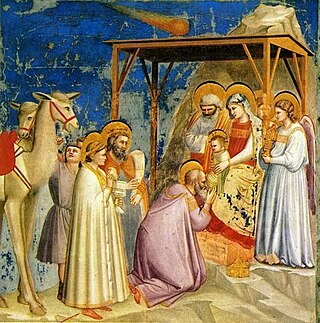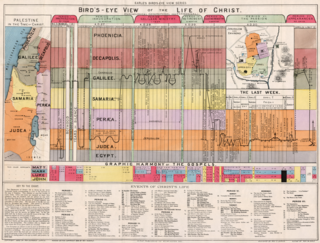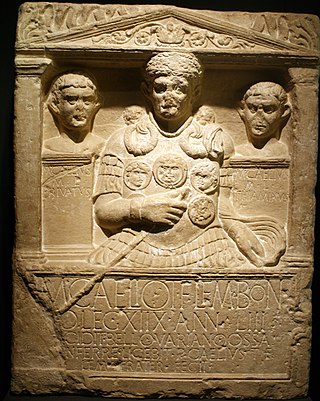Related Research Articles

An eclipse is an astronomical event which occurs when an astronomical object or spacecraft is temporarily obscured, by passing into the shadow of another body or by having another body pass between it and the viewer. This alignment of three celestial objects is known as a syzygy. An eclipse is the result of either an occultation or a transit. A "deep eclipse" is when a small astronomical object is behind a bigger one.
The Julian calendar is a solar calendar of 365 days in every year with an additional leap day every fourth year. The Julian calendar is still used as a religious calendar in parts of the Eastern Orthodox Church and in parts of Oriental Orthodoxy as well as by the Amazigh people.

The Roman calendar was the calendar used by the Roman Kingdom and Roman Republic. Although the term is primarily used for Rome's pre-Julian calendars, it is often used inclusively of the Julian calendar established by Julius Caesar in 46 BC.
Year 12 BC was either a common year starting on Saturday, Sunday or Monday or a leap year starting on Sunday of the Julian calendar and a common year starting on Friday of the Proleptic Julian calendar. At the time, it was known as the Year of the Consulship of Messalla and Quirinius. The denomination 12 BC for this year has been used since the early medieval period, when the Anno Domini calendar era became the prevalent method in Europe for naming years.
AD 1 (I) or 1 CE was a common year starting on Saturday or Sunday, a common year starting on Saturday by the proleptic Julian calendar, and a common year starting on Monday by the proleptic Gregorian calendar. It is the epoch year for the Anno Domini (AD) Christian calendar era, and the 1st year of the 1st century and 1st millennium of the Christian or Common Era (CE).
AD 4 was a common year starting on Wednesday or a leap year starting on Tuesday of the Julian calendar and a leap year starting on Tuesday of the Proleptic Julian calendar. In the Roman Empire, it was known as the Year of the Consulship of Catus and Saturninus. The denomination "AD 4" for this year has been used since the early medieval period, when the Anno Domini calendar era became the prevalent method in Europe for naming years.
6 was a common year starting on Friday of the Julian calendar. In the Roman Empire, it was known as the Year of the Consulship of Lepidus and Lucius Arruntius. The denomination "AD 6" for this year has been used since the early medieval period, when the Anno Domini calendar era became the prevalent method in Europe for naming years.

AD 23 (XXIII) was a common year starting on Friday of the Julian calendar. At the time, it was known as the Year of the Consulship of Pollio and Vetus. The denomination AD 23 for this year has been used since the early medieval period, when the Anno Domini calendar era became the prevalent method in Europe for naming years.
The 0s BC is the period between 9 BC and 1 BC, the last nine years of the before Christ era. It is one of two "0-to-9" decade-like timespans that contain nine years, along with the 0s.
Year 14 BC was either a common year starting on Thursday or Friday or a leap year starting on Wednesday, Thursday or Friday of the Julian calendar and a common year starting on Tuesday of the Proleptic Julian calendar. At the time, it was known as the Year of the Consulship of Crassus and Lentulus. The denomination 14 BC for this year has been used since the early medieval period, when the Anno Domini calendar era became the prevalent method in Europe for naming years.

Year 363 (CCCLXIII) was a common year starting on Wednesday of the Julian calendar. At the time, it was known in Rome as the Year of the Consulship of Iulianus and Sallustius. The denomination 363 for this year has been used since the early medieval period, when the Anno Domini calendar era became the prevalent method in Europe for naming years.
Year 2 BC was a common year starting on Thursday or Friday of the Julian calendar and a common year starting on Wednesday of the Proleptic Julian calendar. At the time, it was known as the Year of the Consulship of Augustus and Silvanus. The denomination 2 BC for this year has been used since the early medieval period, when the Anno Domini calendar era became the prevalent method in Europe for naming years.
Year 7 BC was a common year starting on Saturday or Sunday of the Julian calendar and a common year starting on Thursday of the Proleptic Julian calendar. In the Roman world, it was known as the Year of the Consulship of Tiberius and Piso. The denomination 7 BC for this year has been used since the early medieval period, when the Anno Domini calendar era became the prevalent method in Europe for naming years.
A calendar era is the period of time elapsed since one epoch of a calendar and, if it exists, before the next one. For example, the current year is numbered 2025 in the Gregorian calendar, which numbers its years in the Western Christian era.

The Star of Bethlehem, or Christmas Star, appears in the nativity story of the Gospel of Matthew chapter 2 where "wise men from the East" (Magi) are inspired by the star to travel to Jerusalem. There, they meet King Herod of Judea, and ask him:
Where is He who has been born King of the Jews? For we have seen His star in the East and have come to worship Him.

A chronology of Jesus aims to establish a timeline for the events of the life of Jesus. Scholars have correlated Jewish and Greco-Roman documents and astronomical calendars with the New Testament accounts to estimate dates for the major events in Jesus's life.
The Gregorian calendar is the calendar used in most parts of the world. It went into effect in October 1582 following the papal bull Inter gravissimas issued by Pope Gregory XIII, which introduced it as a modification of, and replacement for, the Julian calendar. The principal change was to space leap years differently so as to make the average calendar year 365.2425 days long, more closely approximating the 365.2422-day "tropical" or "solar" year that is determined by the Earth's revolution around the Sun.
Caesar's Comet was a seven-day cometary outburst seen in July 44 BC. It was interpreted by Romans as a sign of the deification of recently assassinated dictator, Julius Caesar. It was perhaps the most famous comet of antiquity.
AD 2 (II) or 2 AD was a common year starting on Sunday or Monday of the Julian calendar and a common year starting on Sunday of the proleptic Julian calendar. In the Roman Empire, it was known as the Year of the Consulship of Vinicius and Varus, named after Roman consuls Publius Vinicius and Alfenus Varus, and less frequently, as year 755 AUC within the Roman Empire. The denomination "AD 2" for this year has been used since the early medieval period, when the Anno Domini calendar era became the prevalent method in Europe for naming years.

The 0s began on January 1, AD 1 and ended on December 31, AD 9, covering the first nine years of the Common Era. It is one of two "0-to-9" decade-like timespans that contain nine years, along with the 0s BC.
References
- ↑ Pettinger, Andrew (2012). The Republic in Danger: Drusus Libo and the Succession of Tiberius. OUP Oxford. pp. 62ff. ISBN 978-0-19-960174-5.
- ↑ Spears, Tom (December 4, 2005). "Star of Wonder". Ottawa Citizen. p. A7. "Michael Molnar announced 10 years ago his conclusion that the Star of Bethlehem was in fact a double eclipse of Jupiter in a rare astrological conjunction that occurred in Aries on March 20, 6 BC, and again on April 17, 6 BC. ... Mr. Molnar believes that Roman astrologers would have interpreted the double-eclipse as signifying the birth of a divine king in Judea." However, astronomical software such as Stellarium shows that on March 20, the occultation of Jupiter by the Moon could not be seen from Rome, as the Moon passed by the planet without obscuring it. Furthermore, the event on April 17 began when Jupiter was 38 degrees above the horizon, at 2pm, i.e. in daylight, so it is extremely unlikely that this event would have been seen either.